

Allotment garden design has evolved over time, and new approaches and ideas continue to emerge.
Here are some new ways and trends in allotment garden design:
Vertical Gardening
Vertical gardening is gaining popularity in urban areas where space is limited. This design technique involves growing plants vertically on structures such as trellises, walls, or stacked containers. It maximizes space utilization, allows for more plants to be grown in a smaller area, and creates an aesthetically pleasing vertical garden.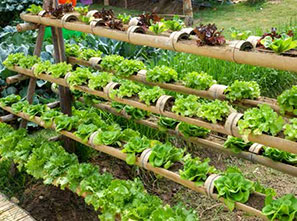
Permaculture Design
Permaculture design principles are being increasingly applied to allotment gardens. Permaculture aims to create sustainable ecosystems that are self-sufficient and require minimal external inputs. Design elements include companion planting, water catchment systems, composting areas, and creating habitats for beneficial insects and wildlife.
Bee-Friendly Gardens
With the decline of pollinators, allotment gardens are being designed to support bee populations. Incorporating bee-friendly flowers, providing nesting sites for solitary bees, and minimizing pesticide use are essential aspects of this design approach. Bee-friendly gardens promote biodiversity and enhance pollination within the allotment.
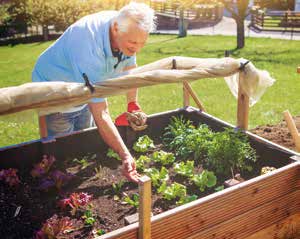 Raised Bed Gardening
Raised Bed Gardening
Raised beds are becoming a popular design feature in allotment gardens. Raised beds provide several benefits, including improved soil drainage, better control of soil quality, and easier access for planting, maintenance, and harvesting. They also create defined spaces for different crops and can be aesthetically pleasing with the use of attractive borders.
Sensory Gardens
Sensory gardens are designed to engage all five senses—sight, smell, touch, taste, and sound. These gardens include a variety of plants with different colors, fragrances, textures, and flavors, as well as elements such as wind chimes or water features. Sensory gardens offer a multi-dimensional experience, promoting relaxation, mindfulness, and sensory exploration.
Community Spaces
Allotment gardens are increasingly being designed as community spaces where people can come together and interact. Design features may include communal seating areas, shared tool sheds, gathering spaces, and areas for social events or workshops. Creating spaces that foster community engagement enhances the social aspect of allotment gardening.
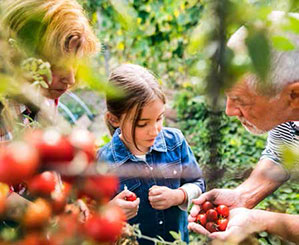 Edible Landscaping
Edible Landscaping
Edible landscaping combines ornamental plants with edible crops, creating visually appealing gardens that also provide food. This design approach incorporates fruit trees, berry bushes, and colorful edible flowers alongside traditional vegetable beds. Edible landscaping adds diversity, aesthetics, and practicality to allotment gardens.
Smart Garden Technology
Advancements in technology have led to the development of smart gardening tools and systems. These include automated irrigation systems, soil sensors, weather monitoring devices, and smartphone apps for tracking and managing garden tasks. Smart garden technology helps gardeners optimize resource usage, increase efficiency, and monitor plant health.
These are just a few examples of new ways and trends in allotment garden design. Ultimately, the design of an allotment garden can be customized based on individual preferences, available space, and local environmental conditions. The key is to create a design that maximizes productivity, promotes sustainability, enhances aesthetics, and suits the needs and interests of the gardeners involved.
Willy Goethals
Honorary President of allotment garden park ‘Slotenkouter’, Ghent, Belgium
Board member of East Flanders’ Provincial Allotment Association
published in "Hyphen no. 79"
Preface
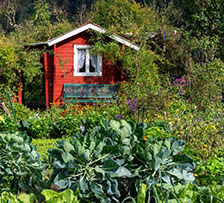 Whether or not it’s useful, necessary or desirable for allotment garden parks to be enclosed entities or made accessible to the general public is difficult if not impossible to describe in its generality in an European context.
Whether or not it’s useful, necessary or desirable for allotment garden parks to be enclosed entities or made accessible to the general public is difficult if not impossible to describe in its generality in an European context.
Indeed, it depends on a variety of factors, including, among others: rural, urban or suburban context, who are the landowners, large or small site, local customs, morality, habits and traditions, prevailing political and economic climate, related costs.
Be that what it may, we will therefore limit ourselves in what follows to some general (historical) considerations from which everyone can draw his/her own conclusions based on the local context.
People throughout all of their history have always tried to shield the land they consider theirs from outsiders by means of enclosures: be it by erecting fences, barriers or walls.
Enclosures define dividing lines and make them visible, but since when exactly have they existed? On Stone Age paintings, for example in the famous Lascaux cave, grid structures are repeatedly found alongside animals, which some scholars interpret as enclosures. A few thousand years after these first painters, people settled here and there permanently and made claims on the land they worked on. Demarcation became necessary to make clear who worked which piece of land, but also to secure it from unwanted visitors.
The original sin
For the philosopher Jean-Jacques Rousseau, the fence was the symbol of all evil from the beginning. According to Rousseau, people in their original state were equal, happy and content. This was in contrast to bourgeois society, characterised by inequality and distrust. In the fence, Rousseau saw the cause of conflicts between people: "The first man who surrounded a piece of land with a fence and had the idea of saying, 'This is mine', and found people simple enough to believe him, was the real founder of bourgeois society. How many crimes, wars, murders, how much misery and horror he would have spared humanity if he had pulled out the poles or stepped over the ditch and shouted to his fellow men, "Beware of believing this imposter; you are lost if you forget that the fruits belong to all, but the earth belongs to no one."
So for Rousseau, the fence was the cause of inequality between people, and he would probably be proved right today if he saw the so-called "gated communities" that have taken off in many countries of the world as a sign of distinction. Those who can afford it live shielded and among their like-minded fellow men in one of these ‘gated communities’.
The separation from other social classes, the fear of real or perceived crime and the affirmation that one can afford this style of living contribute to the popularity of such complexes in many countries.
Critics, however, see in this way of life the danger of certain classes separating themselves from the rest of the population, staying in their bubble and thus weakening social cohesion.
The fence also plays a role in the Christian art of the Middle Ages; the genre of the 'hortus conclusus', i.e., the enclosed or fenced garden, developed in the Gothic period. It goes back to the biblical Song of Songs, in which the bride is compared to a "closed garden". In these artworks, Mary is shown in a garden that is shielded from the sinful outside world by a fence or a rose hedge. Flowers such as lilies or roses grow in the garden itself, representing Mary's purity.
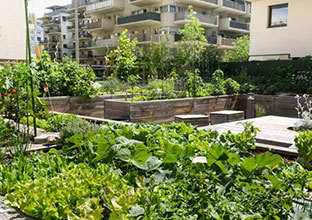 We also find traces of this in linguistics: while the word (Zaun) in German means a border or barrier, relatives of this word such as 'town' in English and even more the Dutch word 'tuin' refer to an enclosed area enclosed by a fence.
We also find traces of this in linguistics: while the word (Zaun) in German means a border or barrier, relatives of this word such as 'town' in English and even more the Dutch word 'tuin' refer to an enclosed area enclosed by a fence.
Allotment gardens have always been subject to major changes but modern tendancy is to integrate them better not to say wholly into the surrounding social fabric. As a consequence, in a lot of cases, the tenants see their privacy threatened. There’s a great deal of fear of losing privacy when strangers suddenly look over the fence into the garden.
A paradise on a Monday morning
Most of our readers will be able to effortlessly recall the picturesque scene below: if there’s a paradise on a Monday morning, then it is the allotment garden, anywhere in or at the outskirts of a major city. Warm late summer light shines at ten o’clock in the morning and there is a stillness as if the seriousness of life was light years away. The long, hot summer and the working zeal of the gardeners have provided for a splendor of flowers. All around, fruits and vegetables are being harvested, raspberries, potatoes, beans, tomatoes. From a distance, only the rattling of a passing train is reminiscent of the hustle and bustle of the city, but who cares?
Gardeners are sitting under the canopy of their garden shed, in front of a coffee and a glorious day. Nevertheless, they are dissatisfied. Their idyll is threatened by a small but nasty revision of the law that the city council is about to vote on: In the future, the allotment garden areas are to be developed with individual walking and cycling paths and made accessible to the general public for all kind of activities.
This “social dimension of the allotment gardens”, as it is called in cheerless administrative language, should bring added value for the population in the city heated up by climate change. From gardeners’ point of view, it means the end of privacy in a piece of home.
Every city government knows that things get complicated when they focus on garden areas
In many cities, investors are seeking space for flats and offices, but at the same time, green spaces are becoming increasingly important in the face of climate change, urban warming, and urban densification.
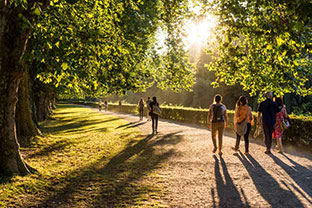 For many city dwellers, gardens are a cheap refuge in a ‘countryside’ and represent a slice of individuality and privacy. Every city government knows that things get complicated when they tackle allotment garden areas.
For many city dwellers, gardens are a cheap refuge in a ‘countryside’ and represent a slice of individuality and privacy. Every city government knows that things get complicated when they tackle allotment garden areas.
Public health and exercise were always at the forefront of allotment gardening. Poor nutrition and precarious living conditions had a disastrous effect on health during industrialisation, and there were fears that the youth would go down the wrong path. In the early 20th century, more and more countries became aware of the necessity for an allotment garden movement.
Gardening becomes a civic duty
At the turn of the century, allotment garden initiatives emerged in many European cities, which ultimately became an integral part of social policy. The factory workers depended for their livelihoods on potatoes and vegetables in their gardens.
During the First World War, the situation worsened: thefts in the gardens increased, which is why the gardeners joined forces. It quickly turned out that just guarding the gardens alone was not enough.
In the Second World War gardening even became a civic duty. Gardeners felt obliged to grow potatoes, using the same arguments that count again today with the emergence of the ecological footprint: milk and meat from 40 ares of land fed only one person, the authorities calculated in advertisements – potatoes on the same area but six people. Food was so scarce and expensive that allotment gardens once again became vital for many people.
Only with the economic boom after the Second World War did self-sufficiency lose its importance. Gardening developed into a leisure activity, vegetable beds were reduced, and lawns, ornamental shrubs and barbecue areas were used instead. At the same time, demand fell and many areas disappeared. The cities used them as land reserves or overbuilt them.
In many cities there are only half as many allotment gardens today as there were in 1945. But even when the economy was booming, the parcelled green spaces reflected the sociological realities: from 1960 immigration made itself felt, and the allotment garden concept had to adapt to this new reality. More and more, the gardens developed into a place of relaxation for a wide variety of city dwellers.
Littering, theft, vandalism
Gardening is a piece of luxury at an affordable price: at Slotenkouter allotment garden park in the city of Ghent gardeners pay +/- 100 euro a year for an area of around 200 square meters.
Some gardeners are all the more horrified at the thought of people suddenly strolling through the gardens. They fear an increase in littering, vandalism and theft. Numerous already are the examples of garden houses and sheds set on fire in allotment parks.
For many, the idea alone of opening the garden site to the general public is looked upon as an intrusion into their personal lives.
Much of the garden debate is reminiscent of the resistance that every reform necessarily brings along and to the victims it inevitably creates. After all, one cannot expect the fattened calf to share the angels' enthusiasm over the return of the lost son.
There are numerous examples where governments have faced opposition to their plans to open up allotment parks to the general public.
The new longing for rural life
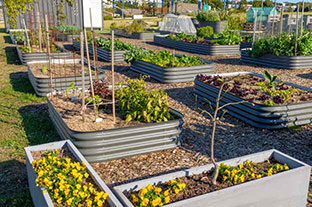 The dispute makes it clear where the journey is going: city authorities will increasingly demand that allotment park sites leave their isolation and integrate fully into the urban fabric. With the urban longing for rural life and with every hot summer, interest in green open spaces increases. We ourselves observe that more and more people are appearing among the gardeners who are neither connected to nature nor have a green thumb.
The dispute makes it clear where the journey is going: city authorities will increasingly demand that allotment park sites leave their isolation and integrate fully into the urban fabric. With the urban longing for rural life and with every hot summer, interest in green open spaces increases. We ourselves observe that more and more people are appearing among the gardeners who are neither connected to nature nor have a green thumb.
The family garden scene is still reacting sceptically to the attempt to better integrate the areas into the city fabric. But if I am not mistaken, the new walkways through the allotment gardens are just the beginning: a hundred years after their spread, allotment gardens are given a new urban planning and sociological function – and more weight. And in my opinion, nothing will be able to stop this trend.
Those of us who are lucky enough to live near parks, open spaces, and green areas know the joys they bring: the calming views of trees and green lawns, the singing of birds, the fresh air, the scent of flowers. Overwhelming evidence demonstrates the benefits of city parks. They improve our physical and psychological health, strengthen our communities, and make our cities and neighbourhoods more attractive places to live and work.
We as garden professionals and citizens need to join the effort to bring parks, open spaces and green areas into the neighbourhoods where all can benefit from them. While government plays a vital role in the creation of public parks, governments cannot do the job alone to set up and maintain all of these allotment sites. We have to come forward and help the government (at community level) by making small committees or trusts to maintain the parks/green spaces within our community. Working together, we can help many more people and our next generations to experience the joys of jogging down a tree-lined path, of a family picnic on a sunny lawn, of sharing a community garden’s proud harvest. We can create the green spaces that offer refuge from the alienating city streets-places where we can rediscover our natural roots and reconnect with our souls.
Willy Goethals, Honorary President of allotment garden park ‘Slotenkouter’, Ghent, Belgium
Board member of East Flanders’ Provincial Allotment Association
published in "Hyphen no. 78"
Tuinhier VZW has participated on the garden days in Beervelde from May 6th to may 8th 2022. The jury found our exhibition stand tasteful decored and rewarded our stand with a golden metal.
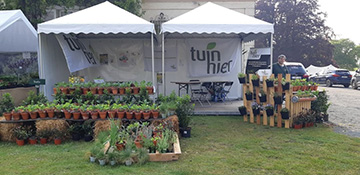
Thanks to all volunteers for helping during the days of the exhibition and realizing of the beautiful stand. Special thanks to Bart Verelst, Leentje Grillaert, Jan De Simpelaere. Thanks to Renaud de Kerchove for the invitation.
We will participate in octobre's edition.
VZW TUINHIER
https://www.parkvanbeervelde.be/en/the-garden-days/garden-days-may-2022/presentation